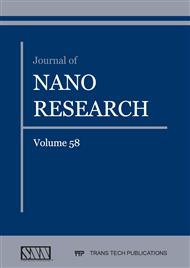[1]
J. Fricke, A. Emmerling, Aerogels, J. Am. Ceram. Soc. 75 (1992) 2027–(2037).
Google Scholar
[2]
L. Kocon, F. Depetis, Ultralow density silica aerogels by alcohol supercritical drying, J. Non-Cryst. Solids. 225 (1998) 96–101.
DOI: 10.1016/s0022-3093(98)00322-6
Google Scholar
[3]
M.R. Ayers, A.J. Hunt, Synthesis and properties of chitosan -silica hybrid aerogels, J. Non-Cryst. Solids. 285 (2001) 123–127.
DOI: 10.1016/s0022-3093(01)00442-2
Google Scholar
[4]
A. Venkateswara Rao, S.D. Bhagat, Synthesis and physical properties of TEOS-based silica aerogels prepared by two step (acid-base) Xero-gel process, Solid State Sci. 6 (2004) 945–952.
DOI: 10.1016/j.solidstatesciences.2004.04.010
Google Scholar
[5]
A. Venkateswara Rao, M.M. Kulkarni, Effect of glycerol additive on physical properties of hydrophobic silica aerogels, Mater. Chem. Phys. 77 (2002) 819–825.
DOI: 10.1016/s0254-0584(02)00207-9
Google Scholar
[6]
L.W. Hrubesh, Aerogels: The world's lightest solids, Chem. Ind. 17 (1990) 824–827.
Google Scholar
[7]
V. Gibiat, O. Lefeuvre, T. Woignier, J. Pelous, J. Phalippou, Acoustic properties and potential applications of silica aerogels, J. Non-Cryst. Solids 186 (1995) 244–255.
DOI: 10.1016/0022-3093(95)00049-6
Google Scholar
[8]
J.W. Long, K.E. Swider Lyons, R.M. Stroud, D.R. Rolison, Design of pore and matter architectures in manganese oxide charge-storage materials, Electrochem. Solid-State Lett. 3 (2000) 453-456.
DOI: 10.1149/1.1391177
Google Scholar
[9]
D.A. Ward, E.I. Ko, Preparing catalytic materials by the sol–gel method, J. Ind. Eng. Chem. Res. 34 (1995) 421-433.
DOI: 10.1021/ie00041a001
Google Scholar
[10]
C.T. Wang, C.L. Wu, I.C. Chen, Y.H. Huang, Humidity sensors based on silica nanoparticle aerogel thin films, Sens. Actuators B 107 (2005) 402–410.
DOI: 10.1016/j.snb.2004.10.034
Google Scholar
[11]
M.L.N. Perdigoto, R.C. Martins, N. Rocha, M.J. Quina, L. Gando-Ferreira, R. Patrício, L. Durães, Application of hydrophobic silica based aerogels and xerogels for removal of toxic organic compounds from aqueous solutions, J. Colloid Interface Sci. 380 (2012) 134–140.
DOI: 10.1016/j.jcis.2012.04.062
Google Scholar
[12]
O. Nilsson, O. Sandberg, G. Bäckström, Thermal conductivity of B2O3 glass under pressure, Int. J. Thermophys. 6 (1985) 267–273.
DOI: 10.1007/bf00522148
Google Scholar
[13]
M. Nogami, Y. Abe, Evidence of water-cooperative proton conduction in silica glasses, Phys. Rev. B 55 (1997) 12108–12112.
DOI: 10.1103/physrevb.55.12108
Google Scholar
[14]
M. Nogami, R. Nagao, C. Wong, Proton conduction in porous silica glasses with high water content, J. Phys. Chem. B 102 (1998) 5772–5775.
DOI: 10.1021/jp981059j
Google Scholar
[15]
M. Nogami, R. Nagao, C. Wong, T. Kasuga, T. Hayakawa, High proton conductivity in porous P2O5–SiO2 glasses, J. Phys. Chem. B 103 (1999) 9468–9472.
DOI: 10.1002/chin.200003007
Google Scholar
[16]
A.K. Ladavosa, A.P. Katsoulidisb, A.Iosifidisc, K.S. Triantafyllidisd, T.J. Pinnavaiae, P.J. Pomonisc, The BET equation, the inflection points of N2 adsorption isotherms and the estimation of specific surface area of porous solids, Microporous and Mesoporous Materials, 151, (2012) 126-133.
DOI: 10.1016/j.micromeso.2011.11.005
Google Scholar
[17]
J.E. Harlan, D. Picot., P.J. Loll., R.M. Garavito., Calibration of Size-Exclusion Chromatography: Use of a Double Gaussian Distribution Function to Describe Pore Sizes, Analytical Biochemistry, 224, (1995) 557–563.
DOI: 10.1006/abio.1995.1087
Google Scholar
[18]
R. Defay, I. Prigogine, S. Bellemans, Surface Tension and Adsorption, Longmans, Green, London, 1966, chap. 16.
Google Scholar


